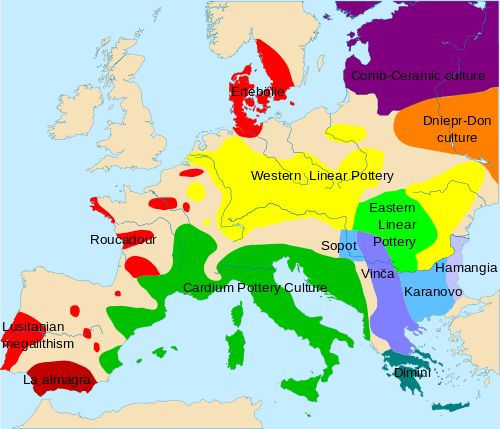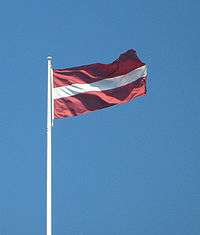Latvian pottery
Bottom: a piece by Ingrīda Cepīte, shaped without using potter's wheel
Latvian pottery (Latvijas keramika or Latvijas podniecība), one of the country's oldest art forms, dates back to the Neolithic. Latgale pottery (Latgales keramika) is the best-known subset of Latvian pottery. The eastern region of Latgale is the most prolific producer of wares.
As a rule, Latvian pottery is characterized by an absence of any painted-on patterns or designs, instead solid colors and gradients are used. Traditionally subdued, earthen hues (greens, browns, etc.) are used; however, artisans can be seen using brighter colors in their unique pieces. Mottled glaze and random artifacts (somewhat reminiscent of the Japanese Shino-yaki) are characteristic of Latvian pottery.
Prehistoric period


The Neolithic Pit–Comb Ware culture (AKA Comb Ceramic culture) that spanned the entire territory of modern-day Latvia derives its name from the pottery characteristic of the time – wares decorated with impressions of a comb-like object. Narva culture spanning the entire territory of modern-day Estonia and Latvia, as well as parts of Lithuania and Western Russia, is a subset of the larger Pit–Comb Ware culture.
Pit–Comb Ware culture is usually thought to have used an early form of what are today known as the Uralic languages, a competing view is that they may have been speakers of a Paleo-European language.[1]
Latgale pottery
Some of the types of wares characteristic to Latgale pottery are vāraunieks (a pot for cooking), medaunieks (a pot for honey storage), sloinīks (a pot for storing fruit preserves), ķērne (a pot for storing sour cream), ļaks (a vessel for storage of oil), piena pods (a pot for storing cow's milk), kazelnieks (a pot for goat milk storage), pārosis (lit. "over-handle", a vessel for bringing food to the field), bļoda (bowl), krūze (a jug or a mug, most often for beer or milk).[2]
Some Latgale pottery wares are not food-related, these include the svilpaunieks (a bird-shaped whistle toy), svečturis (candlestick) and decorative plates and possibly other items meeting more contemporary demands, for example, ashtrays.
Gallery
-

A metallic replica of a vāraunieks to demonstrate its form
-

Medaunieks
-

Sloinīki
-

Ķērne
-

Ļaks
-

Piena pods
-

Kazelnieki
-

Pārosis in birch bark for protection, its handle is missing
-

Bļoda
-

Bļoda
-

Large krūze
-

Large krūze
-

Krūze
References
- ↑ James P. Mallory and Douglas Q. Adams, "Pit-Comb Ware Culture", in Encyclopedia of Indo-European Culture,( Fitzroy Dearborn, 1997), pp. 429–30.
- ↑ Pujāts, Jānis. Latgales keramika. Rēzekne:Latgales kultūras centra izdevniecība, 2002, pages 20-26
